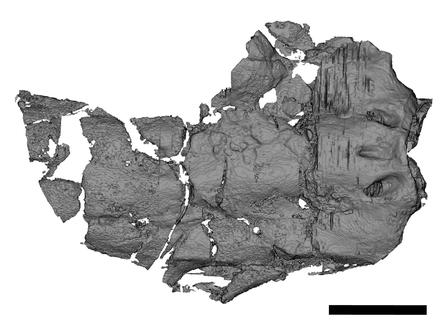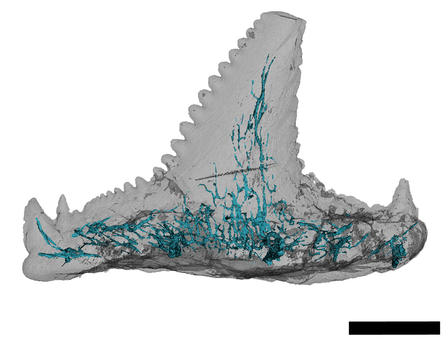Carboniferous Shark Brain Case Study Outlined in New Research Paper
Brain Case of Carcharopsis wortheni Described
Research led by American Museum of Natural History scientists has provided a fresh perspective on a shark that might have been the “Jaws” of the Carboniferous. The Carboniferous shark, Carcharopsis wortheni was first scientifically described in the mid-19th century and was previously known only from its characteristic serrated teeth and fragments of jaw. A fossilised brain case identified as C. wortheni was excavated in 2007 from Upper Mississippian aged rocks in Arkansas (Fayetteville Shale). The fossil was found by Royal Mapes, a retired Ohio University professor and a research associate at the Museum. State-of-the-art imaging techniques were used to provide a unique insight into this important apex predator that lived some 320 million years ago.
The Fossil Cranium (Brain Case) of Carcharopsis wortheni

Picture credit: American Museum of Natural History/Allison Bronson
Insight into Shark Evolution
The shark lived at a critical point in the evolutionary history of our planet, part of a marine fauna that survived the end Devonian mass extinction event which decimated vertebrate species. This ancient Palaeozoic shark, was originally described in 1843 based on its distinctive serrated teeth, a feature that is common in extant sharks such as the formidable Great White (Carcharodon carcharias), an apex marine predator with a frightening reputation, thanks in the main to the film “Jaws” directed by Steven Spielberg, which was based on Peter Benchley’s book. However, serrated teeth are rarely found in Palaeozoic sharks.
A CT Scan Showing the Unique Serrations on a Tooth from Carcharopsis (C. wortheni)

Picture credit: American Museum of Natural History/Allison Bronson
The picture above shows a computer tomography generated image of a Carcharopsis tooth, measuring around five millimetres in length. The blue lines are canals identified within the tooth.
Commenting on the fossil, lead author of the study Allison Bronson, a PhD student at the American Museum of Natural History stated:
“They [the teeth] look a little like what you’d see in a Great White, but are 320 million years old and with different enamel. This is really early to see serrated teeth.”
Carboniferous Shark Fossil Study
Royal Mapes donated the brain case specimen to the New York-based natural history museum, along with a remarkable 540,000 other fossils. Mapes co-authored the Carcharopsis study, which has been published in the journal “Papers in Palaeontology”, American Museum of Natural History curator John Maisey also contributed to the paper.
The scientists used high-resolution computed tomography (CT) imaging to examine the cranium, a tooth, and an isolated portion of a tooth base. Using the scans, they were able to reconstruct the internal canals of the teeth for the first time and found that these are similar to the canals found in today’s sharks.
The arrangement of the shark’s blood vessels—also revealed through CT scans—suggests that Carcharopsis was probably closely related to the group of ancient cartilaginous fish from which today’s sharks and rays evolved. However, more complete fossils are needed to firmly position it in the tree of life.
Everything Dinosaur acknowledges the help of the American Museum of Natural History in the compilation of this article.
Visit the Everything Dinosaur website: Everything Dinosaur.

